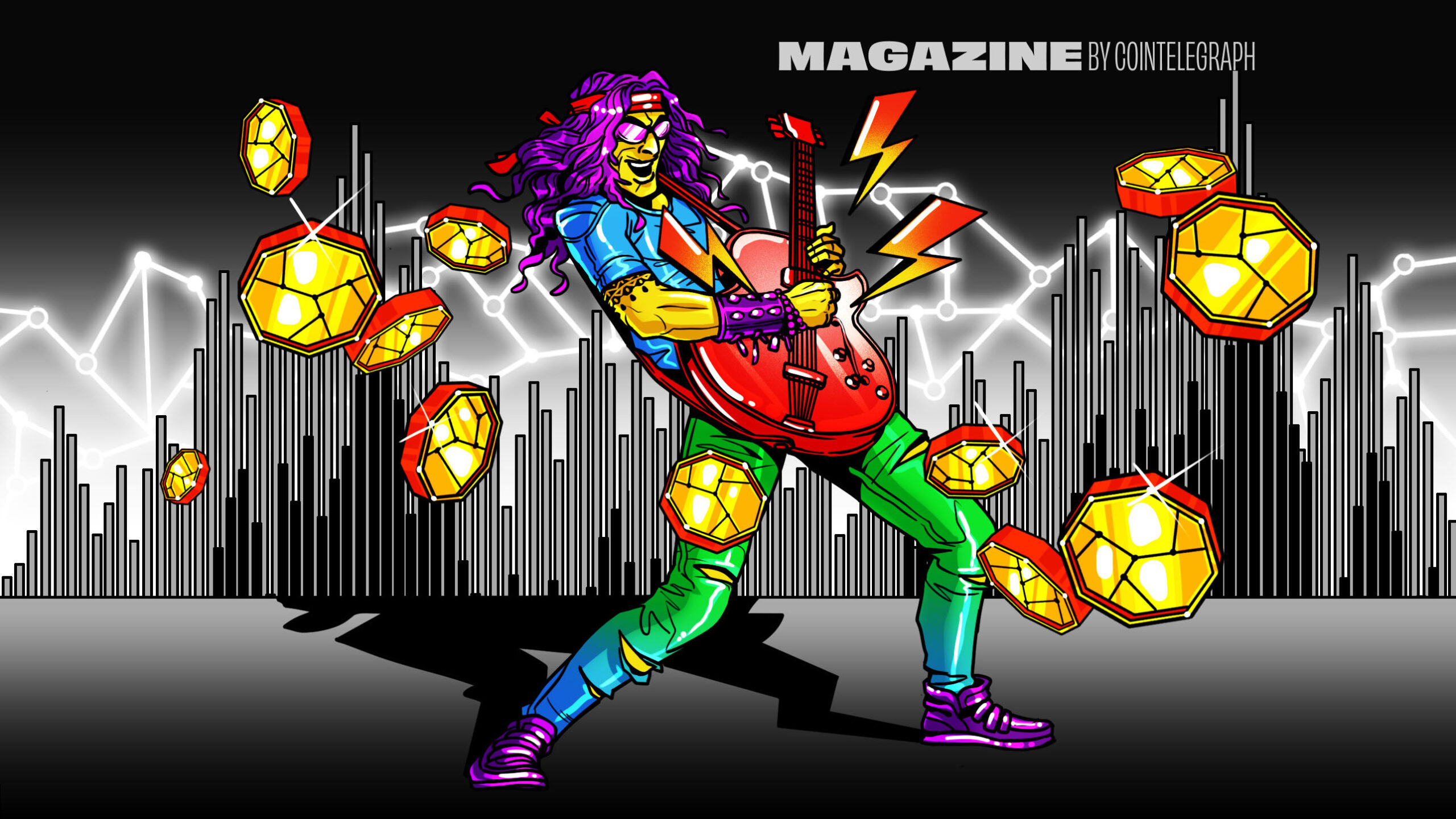Cryptocurrency
Singer Vérité’s fan-first approach to Web3, music NFTs and community building

Carving out a sustainable career as an independent musician is no easy feat. The competition is fierce, support can be hard to find, and earning a living without the financial help of a major record label is an uphill battle. Yet, for those who are able to build a loyal fanbase, the freedom of complete creative control can be liberating.
Technology has long proven to be a potential friend to those musicians willing to embrace it, and nonfungible tokens are the latest innovation that many tech-savvy artists have begun incorporating into their careers. But NFTs remain both controversial and experimental, especially among the mainstream, and music NFTs are still relatively niche.
One artist who has cracked the code to maintaining a successful career as an independent musician is American singer Vérité, who has racked up hundreds of millions of streams without the support of a record label since releasing her first single, “Strange Enough,” in 2014.
After finding success and touring internationally, Vérité became one of the earliest musicians to experiment with NFTs in February 2021. Since then, she has built a strong Web3 community and had several successful high-profile drops, including releasing 1/1 NFTs, selling the master rights to her music, fractionalizing song royalties on the blockchain and giving NFTs to concert attendees. She has done all this while still retaining her dedicated non-Web3 fans, many of whom have little to no interest in crypto.
How does one walk this fine line and successfully integrate Web3 into their career without alienating their existing, perhaps skeptical, fans? Magazine sits down with Vérité to find out.
Don’t over-rely on Web3
For many musicians, Web3 is an exciting frontier filled with new possibilities for fan engagement and revenue generation. However, Vérité believes it is important that artists have diversified revenue streams and marketing strategies and don’t fall into the trap of assuming that the hype surrounding anything, especially NFTs, will last forever.

Building a music career in Web3 is “a bit of a double-edged sword,” Vérité tells Magazine. While it can help bring people together, “it becomes a negative when maybe artists limit themselves to only utilizing those tools and only existing within those communities, not really having the foresight that there was a hype cycle that then broke and these paths to monetization closed.”
“My focus is ‘How do I build a career that can withstand trend cycles, that can refocus on the foundation of my career while trying to push forward to build better?’ because we recognize that a lot of these systems are extremely broken.”
Protect and respect fans
Not every fan wants to join their favorite artist on their Web3 journey, and that’s fine, according to Vérité. When she first started releasing NFTs, she heavily emphasized that she was simply experimenting with the technology. “I was very, very clear that I don’t care if you come with me on this experiment — this is an experiment for me,” she states.
Read also
Vérité actually took it one step further, actively encouraging fans not to join her. “A lot of my communication with them was, ‘Don’t buy this. Don’t participate unless you are fully educated and willing to fully educate yourself and take on the risks.’” Even now, she still tells her fans that they should never feel pressured to participate in anything Web3-related.
“More than monetizing, it’s really protecting the people who have supported my career for the last eight years,” Vérité emphasizes.
It’s clear that not everyone is sold on the power and potential of blockchain. The bear market certainly hasn’t helped the space’s reputation either, with the collapse of crypto exchange FTX making mainstream media headlines and the prices of even blue-chip NFTs crashing 95% from their bull market peaks.
“If you go on my Discord — and I do tag everyone and say, ‘What do you think about crypto and NFTs?’ — people are not jazzed. Most of them, honestly. It’s just general disinterest,” Vérité explains. But it’s not necessarily that her fans actively hate crypto. “I’m finding that people don’t have a desire to do something new because they don’t see a problem, right?”
According to the singer, “NFTs, Web3, how it’s been marketed out to the masses is also wholly unpalatable really to non-tech-native fans.” Instead, she offers the following advice:
“I would more so recommend people to frame it as utilizing tools because it’s a weird market, and it’s hard to justify some of the scams and the negative aspects that can cause real harm to someone who isn’t knowledgeable or educated on those things.”
Offer an option, not a requirement
Instead of forcing fans to join her on-chain, Vérité instead focuses on building experiences with a Web3 element that is present but optional. She describes her approach as offering a “door” for fans to enter, one where blockchain functionalities can be unlocked to further enhance the fan experience — but where fans will still enjoy the experience regardless of whether they open the door:
“Do you need to jump the technological hurdle in order to have the experience, right? Or is it just a door? If it’s a door, you can talk about it because it’s not a burden.”
“For me, it’s really trying to consider, ‘What is the experience that we’re offering, what are the actual viable use cases of blockchain technology that we can tack on that aren’t burdensome?’” she says.
One example is “The Vérité Crewneck,” a tech-enabled sweatshirt the singer dropped in late 2022 in collaboration with IYK, a company working with brands, artists and creators to develop phygital experiences. The sweatshirt has a near-field communication, or NFC, chip embedded in the sleeve, which can be scanned to access exclusive content and unlock an NFT representing a certificate of authenticity.

Vérité explains that fans who bought the sweatshirt received “premier access to the next era of my records.” Buyers could scan the chip with their phones and get early access to music and perks such as behind-the-scenes content. “That was the main value proposition — not a Web3 activation, right?”
But the landing page also features an option to verify the garment, through which curious fans can receive their NFT.
Fans are at the center of it all
Between straight-up telling fans not to purchase her NFTs to offering them experiences where the Web3 option is an added bonus, Vérité’s fan-centric approach has undoubtedly played a significant role in her ability to push boundaries — and see success — in Web3 while still maintaining a loyal non-Web3 fanbase. Or, in her words, “My fans come first, and I don’t have fans just so that I can sell them shit all the time.”
Regarding her long-term hope for the future of blockchain and music, Vérité says her vision is that “we can demystify the black box of data that exists between artists and their fans, that is held by social platforms, ticketing companies, etc., and that blockchain actually does have the ability to make that information transparent so that artists can communicate directly to the people who support them and reward them in long-term scenarios.”
If the hype is to be believed, this dream may one day come true. But based on Vérité’s experience at the forefront of it all, it seems the only way the music-Web3 revolution will be truly successful is if fans are placed at the center of it.
Subscribe
The most engaging reads in blockchain. Delivered once a
week.

Cryptocurrency
Ethereum Foundation, Whales, and Hackers: What’s Driving the ETH Sell-Off?

TL;DR
- Whales, hackers, and the Ethereum Foundation wallets moved over $500M in ETH through large sales and withdrawals.
- Ethereum transfers rose to 4.6M ETH, nearing the monthly high of 5.2M recorded in July.
- Staking inflows hit 247,900 ETH, the highest in a month, locking more supply from trading.
Large Withdrawals and Whale Activity
Ethereum (ETH) has seen heavy movement from major wallets over the past few days. On-chain data from Lookonchain shows a newly created wallet pulled 17,591 ETH, worth $81.62 million, from Kraken in just two hours.
Over three days, two new wallets withdrew a combined 71,025 ETH, valued at $330 million, from the exchange.
One of these wallets, address 0x2A92, has withdrawn 53,434 ETH, worth $242.34 million, in two days. This includes a recent purchase of 30,069 ETH, valued at $138.46 million, during a market drop.
Major ETH Holders Offload Millions Amid Price Rally
In contrast, several separate entities have been disposing of some ETH holdings. A wallet tied to a hacker address 0x17E0 sold 4,958 ETH for $22.13 million at $4,463, securing a profit of $9.75 million. Earlier this year, the same address sold 12,282 ETH at $1,932 and later bought back part of the amount at higher prices.
A different whale sold 20,600 ETH for $96.55 million over the past two days, generating a profit of more than $26 million after holding the position for nine months.
Meanwhile, an Ethereum Foundation-linked wallet, 0xF39d, sold 6,194 ETH worth $28.36 million in the last three days at an average price of $4,578.
Recent sales from the same wallet included an additional 1,100 ETH and 1,695 ETH for over $12.7 million combined.
The #EthereumFoundation-linked wallet(0xF39d) sold another 1,300 $ETH($5.87M) at $4,518 ~11 hours ago.
Over the past 3 days, this wallet has sold a total of 6,194 $ETH($28.36M) at an average price of $4,578.https://t.co/4hfCWymHVG pic.twitter.com/ErUyEY8SJy
— Lookonchain (@lookonchain) August 15, 2025
Network Activity on the Rise
CryptoQuant data shows Ethereum’s total tokens transferred have been climbing since August 9. After ranging between 1 million and 3 million ETH through late July and early August, transfers have risen to 4.6 million ETH, approaching the monthly high of 5.2 million recorded in mid-July. This increase has occurred alongside a price rally from about $3,400 to $4,600.
Interestingly, staking inflows generally stayed between 20,000 and 80,000 ETH per day over the past month. On August 14, inflows jumped to 247,900 ETH, the highest in the period.
At the time, ETH was trading near $4,600. Large staking deposits reduce the amount of ETH available for immediate trading, as staked coins are locked for a set period.
In the meantime, ETH trades at $4,647 with a 24-hour volume of $68.25 billion, down 2% on the day but up 19% over the week.
Binance Free $600 (CryptoPotato Exclusive): Use this link to register a new account and receive $600 exclusive welcome offer on Binance (full details).
LIMITED OFFER for CryptoPotato readers at Bybit: Use this link to register and open a $500 FREE position on any coin!
Cryptocurrency
Massive DOGE Whale Activity Hints at $1 Breakout

TL;DR
- Whales bought two billion DOGE this week, lifting their combined holdings to 27.6 billion coins.
- A single 900M DOGE transfer worth $208M to Binance drew attention to large exchange movements.
- DOGE broke key resistance, with momentum building for a possible push toward the $1 price mark.
Price and Market Moves
Dogecoin (DOGE) traded at $0.23 at press time, slipping 4% over the past day but still showing a 2% gain for the week. Daily turnover came in at about $6.18 billion.
Meanwhile, the broader crypto market saw over $1 billion in liquidations. Hotter-than-expected US Producer Price Index data pushed traders to scale back expectations of a near-term Federal Reserve rate cut. DOGE had roughly 290,500 coins liquidated during the sell-off.
On the two-week chart, analyst Trader Tardigrade notes that DOGE has cleared a downward-sloping resistance line after completing what appears to be a “wave V” in an Elliott Wave sequence. Similar setups in the past, where prolonged declines stayed within falling channels before breaking higher, have been followed by sharp rallies.
$Doge/2-week#Dogecoin is gaining strong momentum to surge above $1 pic.twitter.com/TuSEKr19nv
— Trader Tardigrade (@TATrader_Alan) August 15, 2025
Momentum gauges are also turning up. The Stochastic RSI, which had dropped into oversold territory, is now heading higher. Previous reversals from this zone have coincided with sustained upward moves. The current formation points to a possible run that could carry DOGE past the $1 mark.
Heavy Whale Buying and Large Transfers
As reported by CryptoPotato, blockchain data shows large investors have added two billion DOGE in the past week, spending just under $500 million. That brings their holdings to about 27.6 billion coins, or 18% of the supply. The buying streak has prompted speculation within the community.
Recently, Whale Alert flagged a 900 million DOGE transfer worth about $208 million into Binance. The tracking indicates that it originated from a wallet connected to the exchange, likely as an internal activity. The address involved holds 2.88 billion DOGE, one of the largest balances on the network.
Ali Martinez also reports that transactions above $1 million reached a one-month high, with activity building since early August and peaking as DOGE traded at $0.25.
Whales are back! Dogecoin $DOGE activity at a 1-month high. pic.twitter.com/C83Pv68mCt
— Ali (@ali_charts) August 14, 2025
Sentiment Building
Analyst Gordon described the current setup as “a nice bit of consolidation” before a potential breakout, adding,
“This will be one of the first coins normies FLOCK to & the pump will be MASSIVE.”
With whale accumulation rising, high-value transfers increasing, and a bullish technical pattern in play, DOGE is positioned for a potential push toward $1 if momentum holds.
Binance Free $600 (CryptoPotato Exclusive): Use this link to register a new account and receive $600 exclusive welcome offer on Binance (full details).
LIMITED OFFER for CryptoPotato readers at Bybit: Use this link to register and open a $500 FREE position on any coin!
Cryptocurrency
Ripple Price Analysis: XRP at Risk as Key Support Levels Could Trigger Sharp Drop

XRP has recently entered a consolidation phase after a strong rally earlier this summer, with the price action now hovering around key resistance levels on both its USDT and BTC pairs. Yet, while momentum has slowed, the charts still indicate a generally bullish structure, with multiple key support levels remaining firmly in place.
Technical Analysis
By ShayanMarkets
The USDT Pair
On the XRP/USDT daily chart, the price is currently trading near the $3.10 mark, facing a strong resistance zone around $3.40. This follows a breakout above the $2.70 range in July, which has now flipped into a support area.
Both the 100-day and 200-day moving averages are also trending upward and recently formed a bullish crossover around $2.45, reinforcing the medium-term bullish sentiment. If the $3.40 resistance breaks, a push toward the critical $4.00 range becomes likely.
However, the RSI hovering near the neutral 50 level suggests a lack of strong momentum for now, meaning a short-term pullback into the $2.80 support zone is still possible.
This zone will be key for maintaining the bullish structure. Losing it could open the door for a deeper correction toward the 200-day moving average located around the $2.40 mark. Yet, as long as the price stays above the moving averages, the broader trend remains bullish.
The BTC Pair
Looking at the XRP/BTC chart, the pair has recently pulled back after hitting the 3,000 SAT resistance, with the price currently around 2,600 SAT.
This follows a clean breakout above the long-term descending channel and a successful retest of its upper boundary, which coincided with the 200-day moving average and the 2,400 SAT support zone. This confluence remains a key bullish technical factor, as holding above it could attract renewed buying pressure.
That said, RSI levels around 48 show that momentum has cooled after the sharp July rally, meaning XRP may continue ranging between 2,400 SAT and 3,000 SAT in the near term. A decisive close above 3,000 SAT would likely open the path to the 3,400 SAT zone, while losing 2,400 SAT could shift the bias back toward 2,000 SAT support. For now, the structure still favors the bulls as long as higher lows remain intact.
Binance Free $600 (CryptoPotato Exclusive): Use this link to register a new account and receive $600 exclusive welcome offer on Binance (full details).
LIMITED OFFER for CryptoPotato readers at Bybit: Use this link to register and open a $500 FREE position on any coin!
Disclaimer: Information found on CryptoPotato is those of writers quoted. It does not represent the opinions of CryptoPotato on whether to buy, sell, or hold any investments. You are advised to conduct your own research before making any investment decisions. Use provided information at your own risk. See Disclaimer for more information.
Cryptocurrency charts by TradingView.

 Forex3 years ago
Forex3 years agoForex Today: the dollar is gaining strength amid gloomy sentiment at the start of the Fed’s week

 Forex3 years ago
Forex3 years agoUnbiased review of Pocket Option broker

 Forex3 years ago
Forex3 years agoDollar to pound sterling exchange rate today: Pound plummeted to its lowest since 1985

 Forex3 years ago
Forex3 years agoHow is the Australian dollar doing today?

 Cryptocurrency3 years ago
Cryptocurrency3 years agoWhat happened in the crypto market – current events today

 World3 years ago
World3 years agoWhy are modern video games an art form?

 Commodities3 years ago
Commodities3 years agoCopper continues to fall in price on expectations of lower demand in China

 Economy3 years ago
Economy3 years agoCrude oil tankers double in price due to EU anti-Russian sanctions


























